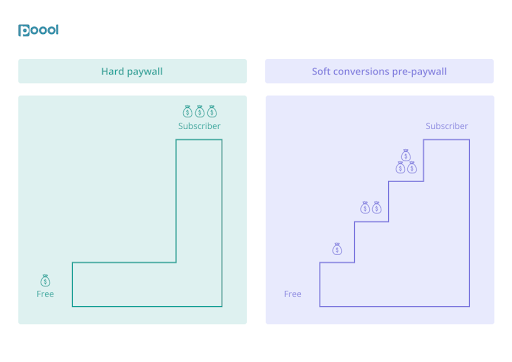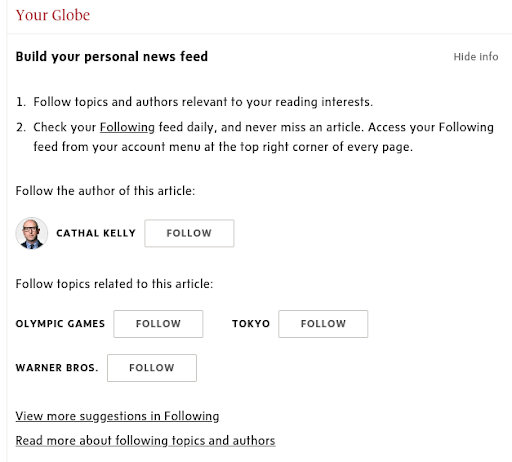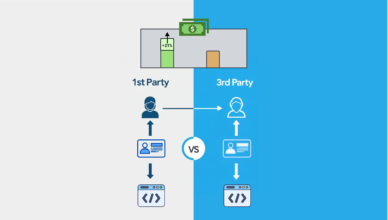The digital publishing industry is currently facing a significant number of business-threatening challenges. Ad revenues are under unprecedented pressure, trust between readers and publishers is gradually disintegrating (but more important than ever), privacy concerns are forcing our market to be remodelled, and subscription has become a hugely competitive industry. To say it’s a difficult time to be a content producer is perhaps an understatement…
However, there is light at the end of the tunnel. In fact, by simply employing a first-party data strategy with a registration wall, publishers of any content type of any company size can overcome the majority of these challenges, future-proofing their business and establishing a variety of complementary revenue streams.
Specifically, a registration wall blocks content and asks a visitor to your site to create a free account in exchange for access. It’s a technique employed by some of the most successful publishers (including the New York Times, The Independent & Harvard Business Review) to increase engagement, build lasting relationships, collect first-party data, monetize and more.
So, how does a first-party data strategy, successfully employed thanks to a registration wall, provide the solution to such a variety of challenges for publishers?
The challenge: The cookieless future is fast approaching – Chrome may have delayed the inevitable until 2023, but the time to prepare is now, building the foundations for survival in this new internet future.
The solution: Registration walls encourage visitors to create a free account on your site, establishing a value exchange – your user gets access to content and (hopefully) additionally benefits such as being able to save content for later, whilst you are now able to understand consumer habits and create a single view of the user (as they have to log in on every visit). With this, you’ll no longer need to be reliant on 3rd party data but, instead, be able to collect owned, high-quality data from your audiences to inform your strategy and, importantly, in a way that respects your user’s privacy.
The challenge: Advertising revenue is continuing to decrease – Given that Poool has noted a fall in cookie consent rates of up to 20% in the last 6 months (due to tightening regulations such as those by the CNIL in France) and that ads are two times less valuable without consent, we can calculate that monetizing potential from ads is set to decrease by 10% every six months… And, if there was a need for anything else to add to the worries, 42% of users are employing an ad blocker and up to 50% of internet access is done on mobile, lowering the value of advertising yet further.
The solution: With an understanding of your individual, registered readers, you’ll be able to target ads to the right user at the right time, making this revenue stream significantly more profitable, counteracting the falling trend in the value of advertising. What’s more, personalized ads provide a better user experience – granted, and adverts are never loved by online readers. Still, ads that are adapted to their profile and interests make for a far better experience.
The challenge: Subscription markets are hyper-competitive – To paywall or not to a paywall, that really is the question for many publishers. It’s indeed a way to diversify revenue streams and establish predictable monetization, but how do you convert the most number of users? How do you increase CLV? And how do you monetize and engage audiences who are unlikely to subscribe?
The solution: There are, in fact, 2 options here to solve this challenge.
Firstly, you could choose not to employ a paywall. In this case, registration walls provide a way of establishing a different form of value exchange with your audience (they create a free account, and you collect first-party data) as well as helping to increase revenue in other areas (advertising, better selling and upselling thanks to data insights, improved user experience to boost loyalty, etc.). A registration wall, therefore, allows you to monetize your content and collect valuable 1st party data without ever having to block users and ask them to pay to access your content (after all, a paywall isn’t for everyone). We’d also recommend considering other wall types, such as a newsletter or survey wall, to exchange different forms of value from users, still without them needing to pay a penny.
Alternatively, you may want to (or already) employ a paywall and subscription strategy. Here, a registration wall can be hugely valuable to you, providing a soft conversion step prior to the paywall that increases engagement and frequency of content consumption so that, when they do get asked to subscribe, they’re highly more likely to click through the wall. You’ll also have an understanding of the user’s interests and behaviours, meaning you can present them with a subscription offer that’s the most suited to them (increasing conversion rates).
Not only does engagement correlate with conversion rates, but also with retention rates. A more engaged user, who considers your content as valuable and fulfilling a need in their life, is likely to remain as a loyal subscriber in the long term, increasing your CLV and revenues.
The challenge: Personalization is now an expectation amongst users and difficult to achieve cookie-free – Adapting user experiences is essential to achieve high engagement, build strong relationships and foster brand loyalty. However, without data, this isn’t easy to achieve. To add to this, targeted advertising is significantly more profitable but seemingly impossible without cookies…
The solution: As part of the value exchange that a registration wall establishes with your audience, you’ll be able to provide them with an account space and personalizations on your site to improve their user experience. As they log in on every visit, you can present content recommendations based on their consumption habits, set up UX functionalities that allow them to save content for later or see what they’ve read in the past, as well as follow topics or authors.
This is the technique employed by many content producers, from Netflix and their AI personalized home page for each user to the Canadian Globe and Mail who allows registered users to follow topics and interact with content.
Of course, personalization improves the user experience, but it also increases engagement, encourages interaction and helps each individual to see value on your site as they’ll be shown content adapted to their interests (which ultimately increases retention rates).
Overall, a first-party data strategy employed with the use of a registration wall can prove hugely beneficial to publishers, not only solving many of the challenges faced in today’s rapidly changing internet world but turning them into an opportunity to learn about audiences, increase engagement, improve the user experience and boost revenues in a variety of ways.











